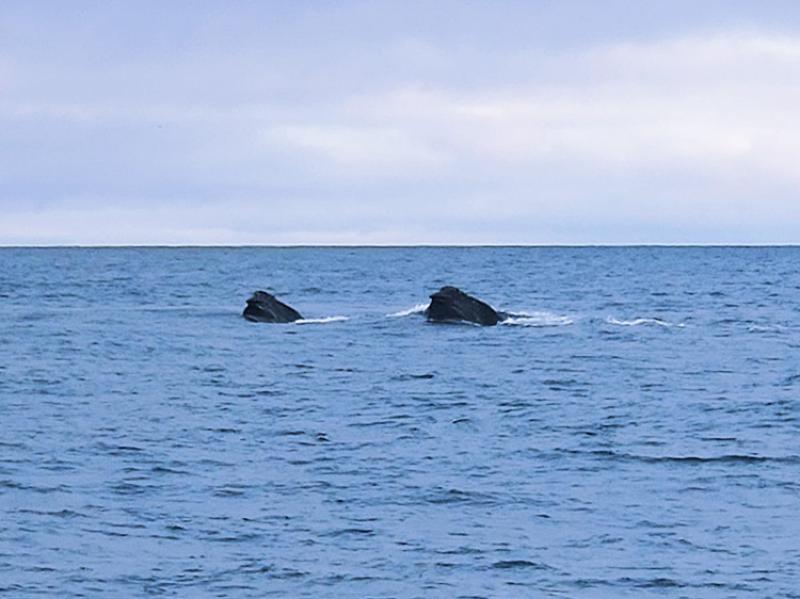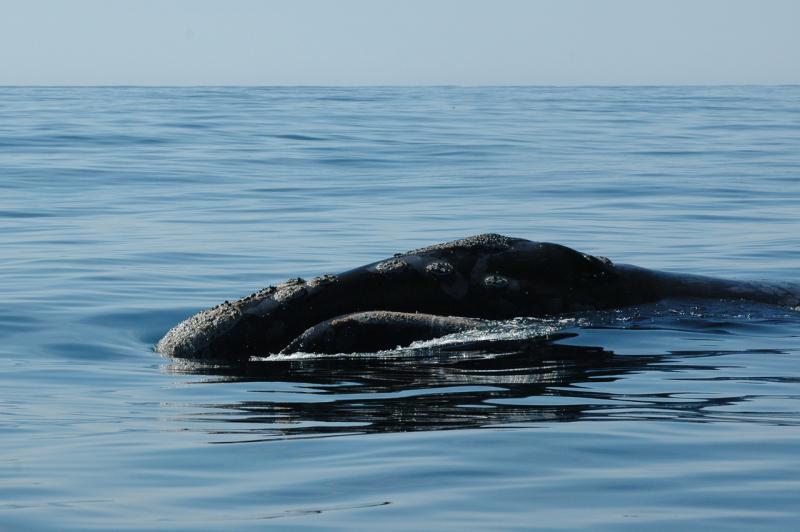In early February, commercial fishermen spotted at least two endangered North Pacific right whales among a large group of around 20 whales. The whales were feeding in waters just northeast of a narrow strait in the Aleutian Islands.
“I took the time to take these pictures and video because the encounter was unique to me. I have watched many thousands of whales feeding in the 35 years I have sailed the North Pacific and Bering, yet none like this,” said Josh Trosvig, who captains the cod fishing vessel Cerulean. “It is important to have a good relationship between industry and the federal and state agencies that monitor the oceans. Hopefully this sighting will add to the knowledge database pertaining to these rare cetaceans.”
Initially unsure of the species, Trosvig sent photos and video of the two whales to an Alaska Department of Fish and Game resource manager based in Dutch Harbor. The resource manager then reached out to NOAA Fisheries colleagues to help identify the whales.
“The whales were spotted east of Cape Sarichef. Josh said there were about 10 pairs feeding and that their heads were just popping up and floating for a bit. He, and others on his boat, could see baleen and said the heads consisted mainly of a lower jaw with just a small upper jaw,” said Asia Beder, assistant area management biologist, Bering Sea-Aleutian Islands, Alaska Department of Fish and Game. “I haven’t seen behavior like this before so thought I would forward the images to people who are more familiar with whales.”
NOAA Fisheries scientist Jessica Crance, Alaska Fisheries Science Center, confirmed that the two whales in the shared photos and video were indeed North Pacific right whales. “So we know that at least two in this group were North Pacific right whales. The fishermen also reported that humpback and fin whales were also in the group.”
Only an estimated 30 individuals are left in the eastern North Pacific population. As a result, every sighting is critical.
“To my knowledge, this is the first sighting of North Pacific right whales in winter in the Bering Sea,” she said. “We have acoustic detections, or sound recordings, of whale calls during January, but no actual sightings from this time of year.”
NOAA Fisheries is working with the U.S. Coast Guard to issue a broadcast to mariners asking them to proceed with caution. We're also are asking mariners to report any North Pacific right whale sightings as they transit Unimak Pass, which is near where the whales were last seen. This is the primary shipping lane from Northwest America and Canada to China, Japan, and South Korea.
North Pacific right whales are slow moving and spend most of their time on the surface. As a result, they are vulnerable to ship strikes
If possible, NOAA Fisheries is asking mariners in the vicinity of Unimak Pass and Dutch Harbor to:
- Slow vessel speed to 10 knots or less
- Keep watch
- Maintain at least 500 yards distance from whales
North Pacific right whales are distinguished by a wide flat back, no dorsal fin, a V-shaped blow, and white bumps on the tops of their heads.
“We are so grateful to the two fishermen and to Alaska Department of Fish and Game who shared photos and video, which enabled us to collect this valuable location and habitat use information,” said Jenna Malek, the North Pacific right whale recovery coordinator for the Alaska Regional Office of NOAA Fisheries.
NOAA Fisheries would also like to encourage any other fishermen or mariners to please call NOAA Fisheries at (619) 733-1386 with any sighting reports or photos. If unable to call, please radio the U.S. Coast Guard on VHF CH 16 and they will relay the report.
Next week, February 14–18, NOAA Fisheries kicks off Whale Week. We’ll be sharing lots more information on North Pacific right whales and other cool whales.



